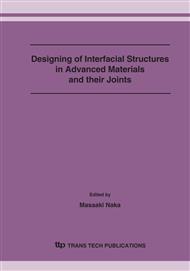p.155
p.161
p.167
p.173
p.179
p.185
p.189
p.195
p.203
Preparation of Tungsten Carbide/Stainless Steel Functionally Graded Materials by Pulsed Current Sintering
Abstract:
In this investigation, functionally graded technique has been applied to prepare tungsten Carbide alloys (WC-Co alloys)-austenitic stainless steel to improve corrosion and wear resistance and reduce their fabrication costs. Two types of specimens were prepared by Pulsed Current Sintering (PCS) method. One is fabricated from WC alloy (WC-20 wt% Co, WC-20 wt% Fe-46Ni) powder and SUS316L stainless steel powder, and is designated “powder / powder process“. The other is fabricated from pre-sintered WC alloy and SUS316L plate, and is designated “bulk / bulk process”. Both types of specimens have four functionally graded layers. Mechanical properties of these specimens were evaluated by three points bending test, and microscopy observations were made to their microstructures. Although the proper bending strength of bulk / bulk process specimen was obtained, the optimum sintering condition is sensitive to the sintering temperature and function graded layers.
Info:
Periodical:
Pages:
179-184
Citation:
Online since:
September 2007
Authors:
Price:
Сopyright:
© 2007 Trans Tech Publications Ltd. All Rights Reserved
Share:
Citation:


